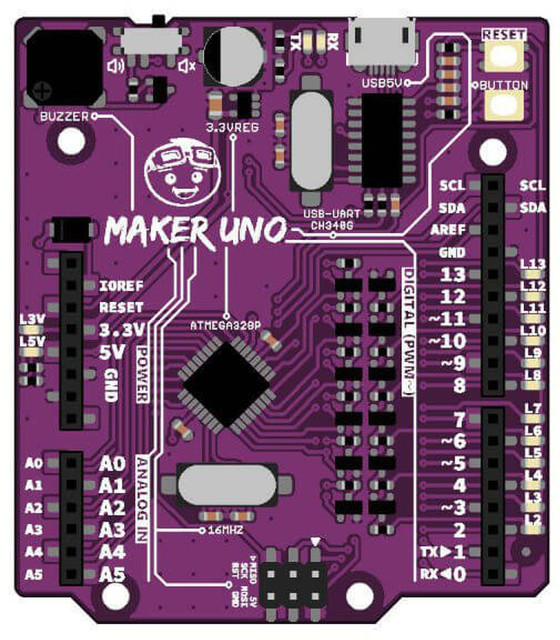Arduino UNO is one of the older Arduino boards, but also one of the most popular, and there are already many clones, which you can buy for as low as $3 shipped. But Malaysian based Cytron Technologies has decided to make their own Arduino UNO Compatible board, designed specially for students to learn coding and microcontroller, that brings some tweaks to the original design.
First, they’ve done away with the power jack, and instead went with a more convenient micro USB port for power. They also added an LED for each digital I/O, so students can easily see I/O activity, and finally included a piezo buzzer to play sounds or melodies, as well as a push button.
 Maker UNO specifications with differences highlighted in bold:
Maker UNO specifications with differences highlighted in bold:
- MCU – Microchip Atmel ATMega328P AVR micro-controller @ 16 MHz with 32KB flash, 2KB SRAM, 1KB EEPROM
- I/Os
- 14x digital I/Os including 6x PWM
- 6x 10-bit analog inputs
- 1x UART, 1x I2C, 1x SPI
- 2x external interrupts
- DC current per I/O: 20 mA
- LED for pin 2 to pin 13
- USB to Serial – CH340G (instead of ATmega16U2)
- Programming – 6-pin ISP header
- Misc – Reset button, Push button (pin 2), piezo buzzer (pin 8) with selector switch
- Power Supply – 5V input via micro USB port; board operating voltage: 5V
- Max DC Current
- 5V – Depends on USB source (Original Arduino UNO: 1A)
- 3.3V – 500 mA (Original Arduino UNO: 50 mA)
Since the board is compatible with Arduino UNO, you could just get started by downloading the official Arduino IDE on Arduino website, but the company has also written a bilingual guide (English, Malay) to help people get started with the board.
Maker UNO is sold for $6.00 on Tindie, but shipping adds $11.50 and up, so you’d have to buy a few to keep the unit price below $10. Alternatively, if you are based in Malaysia, Cytron Technologies sells it directly on their website for 26.5 MYR ($6.8 US) including local taxes with shipping free if you spend more than 100 MYR, or pick the board up in Penang. They also do oversea shipping, but it’s quite expensive since they only use DHL or Fedex.

Jean-Luc started CNX Software in 2010 as a part-time endeavor, before quitting his job as a software engineering manager, and starting to write daily news, and reviews full time later in 2011.
Support CNX Software! Donate via cryptocurrencies, become a Patron on Patreon, or purchase goods on Amazon or Aliexpress




